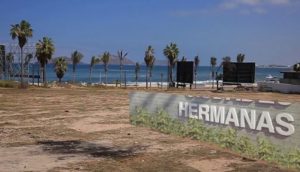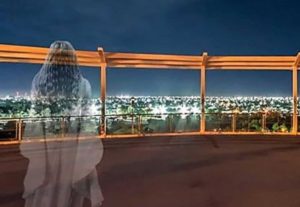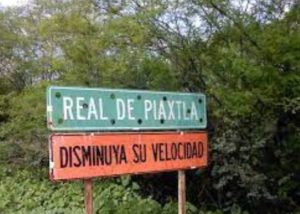Podcast: Play in new window | Download
Subscribe: Apple Podcasts | RSS
Located in the northwestern part of Mexico on the Pacific coast, the Mexican state of Sinaloa is home to beautiful beaches, deserts, mountains and subtropical forests. It is also home to many legends. Here are four.
- The Three Indigenous Princesses
Long before the Spanish arrived in the region of the current state of Sinaloa, there lived three beautiful sisters who were the daughters of a Cáhita king who ruled a small kingdom from the town of Mázatl, or “The Place of the Deer,” today called Mazatlán. The inhabitants of this tiny Cáhita kingdom loved their ruler very much and their affection extended to the girls, who in addition to being pretty were very kind and virtuous.
 The small capital city of Mázatl was located at the mouth of the Quelite River and people in the kingdom enjoyed a high standard of living, growing fruits and vegetables, gathering abundant fish from the ocean and raising a variety of animals. The climate was wonderful, calm, peaceful and hot. However, one fateful day, the weather began to change and there were terrible hurricane-force winds that washed away houses and crops. The sea began to rise higher than ever before seen. The ruler, fearful for the lives of his subjects, went to the wise shamans of the kingdom to ask them for advice about what should be done in order to stop the terrible catastrophe that was happening. The shaman priests, after consulting the gods, told the ruler that the solution was to sacrifice one of his daughters. The king was reluctant to kill one of his girls, but in the face of the terrible winds and continuous rain, one of the girls appeared before her father and informed him that she was willing to sacrifice herself to stop the horrible weather.
The small capital city of Mázatl was located at the mouth of the Quelite River and people in the kingdom enjoyed a high standard of living, growing fruits and vegetables, gathering abundant fish from the ocean and raising a variety of animals. The climate was wonderful, calm, peaceful and hot. However, one fateful day, the weather began to change and there were terrible hurricane-force winds that washed away houses and crops. The sea began to rise higher than ever before seen. The ruler, fearful for the lives of his subjects, went to the wise shamans of the kingdom to ask them for advice about what should be done in order to stop the terrible catastrophe that was happening. The shaman priests, after consulting the gods, told the ruler that the solution was to sacrifice one of his daughters. The king was reluctant to kill one of his girls, but in the face of the terrible winds and continuous rain, one of the girls appeared before her father and informed him that she was willing to sacrifice herself to stop the horrible weather.
When the young woman was walking along the beach towards the sea ready to die, her two sisters caught up with her, stating that they would not let her die alone. So, the three of them joined hands, entered the stormy ocean and disappeared. When the next day dawned, the weather had drastically improved: there were no longer any strong winds, the rain had stopped, and the sea no longer threatened to overwhelm the coastal settlement of the Mázatl Kingdom. The first people who went out to the beach that morning were amazed at what they saw: not far from the shore three beautiful islands had appeared. The indigenous names of these islands are lost to history, but they are now known as Isla de Pájaros, Isla de Venados and Isla de los Lobos.
- Silvia
In the 1960s, at the Pérgola de los Mochis, every year a popular dance was held in the month of December, with live music and much joy. One year, some young people came to the dance and brought with them a young man from Mexico City. All were partnered up except the outsider.
When the party was at its peak, the young man from Mexico City noticed a beautiful girl dressed in white. He approached her and invited her to dance. The young woman agreed. As the boy was dancing, he realized that the girl’s hands and cheeks were extremely cold, which intrigued him. At one point the woman in white asked her dance partner what time it was. He replied that it was twelve o’clock, to which she replied that she had to go. The young man wanted to accompany her home, but the beautiful girl told him only to the foot of the steps that led to La Pérgola. As he went downstairs, the boy noticed that the young lady was trembling and offered her his jacket to cover herself, indicating that the next day he would pick it up at her home.
 And indeed, the next day he went to the house of the young woman who had given him her address before leaving the dance the night before. Upon arrival, he knocked on the door and a sad-looking lady opened it. The young man asked her about the girl and explained he had come to the house to get his jacket. He told her the name of the beauty, Silvia, and described her in her beautiful white dress and long, silky black hair. Hearing the young man talk about the girl, the woman thought it was a bad joke, because as she explained to the visitor, the girl had died only three days ago, just when she was turning eighteen, in a terrible accident. The young man was shocked and didn’t know what to say, so the mother showed him the white dress and a photograph of the deceased daughter. As the young man kept doubting, the woman took him to the cemetery where her daughter was buried. Among the graves they found the tombstone on which the girl’s name was written: Silvia. The young man almost died of fright when he realized that on the grave was the jacket with which he had covered the girl to protect her from the cold, which, he figured was none other than the cold of death!
And indeed, the next day he went to the house of the young woman who had given him her address before leaving the dance the night before. Upon arrival, he knocked on the door and a sad-looking lady opened it. The young man asked her about the girl and explained he had come to the house to get his jacket. He told her the name of the beauty, Silvia, and described her in her beautiful white dress and long, silky black hair. Hearing the young man talk about the girl, the woman thought it was a bad joke, because as she explained to the visitor, the girl had died only three days ago, just when she was turning eighteen, in a terrible accident. The young man was shocked and didn’t know what to say, so the mother showed him the white dress and a photograph of the deceased daughter. As the young man kept doubting, the woman took him to the cemetery where her daughter was buried. Among the graves they found the tombstone on which the girl’s name was written: Silvia. The young man almost died of fright when he realized that on the grave was the jacket with which he had covered the girl to protect her from the cold, which, he figured was none other than the cold of death!
Many nights the young man went to La Pérgola with the hope of seeing the young woman again, but he never found her. After a year, on the first anniversary of their meeting, he gave up his search. However, years later many locals affirm seeing a ghostly image of a young woman with beautiful long black hair dressed in white descending the steps of La Pérgola de los Mochis. She seems as if she is looking for someone she cannot find, because the lover that night had given up looking for her.
- San Ignacio de Piaxtla
San Ignacio is the capital of the municipality of the same name located in the state of Sinaloa. It is a small town that is also known by the name of San Ignacio de Piaxtla. It was founded by the Jesuit Diego González de Cueto in 1633 but was built on the ruins of an older indigenous settlement that no longer exists that natives referred to as “Piaxtla.” In the 18th century, mining became very important in the region, and San Ignacio became a flourishing mining town, thanks to the Sierra del Candelero gold mine nearby.
 This mining boom attracted many men who came to San Ignacio along with their families. Among them came a man who did not attract much attention. Some women who washed clothes in the river saw him arrive: a young fellow mounted on a mule that crossed the waters of the river carrying a bundle on the beast’s right side. When the man arrived in town, he asked some children who were playing in the streets if they knew of an inn where he could stay. The children took him to the only one in town. After eating and feeding the mule, the man asked the innkeeper to take care of his animal, since he had to do certain errands, and paid the proprietor with two shiny silver Spanish coins.
This mining boom attracted many men who came to San Ignacio along with their families. Among them came a man who did not attract much attention. Some women who washed clothes in the river saw him arrive: a young fellow mounted on a mule that crossed the waters of the river carrying a bundle on the beast’s right side. When the man arrived in town, he asked some children who were playing in the streets if they knew of an inn where he could stay. The children took him to the only one in town. After eating and feeding the mule, the man asked the innkeeper to take care of his animal, since he had to do certain errands, and paid the proprietor with two shiny silver Spanish coins.
Three days passed and the man with the mule did not return, which is why the innkeeper decided to take the pack he was carrying from the animal so that the mule could rest and took it to a corral. The next day, and as the man did not return, the innkeeper opened the package and found the sculpture of a saint that had the same features as the man who had asked for a lodging. A letter tied with a black ribbon hung from the neck of the carved santo. As everyone in the town was illiterate, the innkeeper took the letter and sent a message to the Mission of Santa Apolonia to have a friar there read it. When the friar read the letter, he was very astonished, as it said: “It is a divine mandate and my own will that I be the patron saint of this town.”
Thus, on November 17, the saint was anointed on the site where a parish would be built. He was none other than Saint Ignatius of Loyola, founder of the Jesuits and chief of the soldiers of God. The town changed its name from Piaxtla and was known from then on as San Ignacio.
- The Treasure of the Charco Verde
The legend of the Charco Verde goes back to the time of the Porfiriato during the final years of the 1800s. This was a time when unsavory characters like Heraclio Bernal, who was known as “El Rayo de Sinaloa,” roamed the highways and byways of the states of Sinaloa and Durango. On the way to Cósala, Sinaloa, Heraclio Bernal was unjustly accused of a crime that he did not commit and for which he went to prison. Bernal was treated poorly while encarcerated and eventually escaped from his confinement. He dedicated himself to banditry to make up for being deprived of his freedom. He attacked the mining centers, both in Durango and Sinaloa, as well as the wagon trains in which the rich miners transported their precious metals already melted down to the large cities where their owners or associates resided. After making one of his visits to the miners and landowners, he disguised himself as a woodcutter in order to escape the persecutions that local hired guns organized against him. The hired guns were at the service of the government and in most cases, also at the service of the rich farmers, miners or landowners. With a part of what Bernal  stole, he helped the people in the regions where he roamed, and the people, in gratitude, told lies to the hired guns to keep them off Bernal’s trail. Over time, Bernal had amassed 20 to 30 bars of silver and gold. With his precious cargo, he headed for the Pueblo Nuevo region and entered the community of Chavarría, located at the edge of the massive El Salto Ranch. While on the lands of the ranch, Bernal was warned by his watchmen that the guards of the mining estates of the State of Sinaloa would catch up with him in one more day. Bernal considered the situation and found it necessary to hide the shipment. Bernal’s men informed him that close to the hacienda at El Salto there was a large green pool, or charco verde, near a ravine and that despite it being dry, the bottom was not visible. With twelve mules heavily loaded with gold and silver bars, Bernal realized that he could not flee, so he ordered his companions to throw the bars of precious metal into the “Charco Verde.” Once the mules were freed from their precious cargo, the bandit was able to escape from his pursuers. Bernal wanted to return to the El Salto Ranch to retrieve his valuable merchandise, but never could, because after several chases and skirmishes, he could never even get close to where he stashed his gold and silver bars. According to some, Bernal’s treasure, without a doubt, is still located at the bottom of the Charco Verde. Over the years there have been many attempts to drain the greenish pond to reclaim the gold and silver, but no one has ever been able to get all the water out. It seems that “El Charco” keeps the treasure all to itself.
stole, he helped the people in the regions where he roamed, and the people, in gratitude, told lies to the hired guns to keep them off Bernal’s trail. Over time, Bernal had amassed 20 to 30 bars of silver and gold. With his precious cargo, he headed for the Pueblo Nuevo region and entered the community of Chavarría, located at the edge of the massive El Salto Ranch. While on the lands of the ranch, Bernal was warned by his watchmen that the guards of the mining estates of the State of Sinaloa would catch up with him in one more day. Bernal considered the situation and found it necessary to hide the shipment. Bernal’s men informed him that close to the hacienda at El Salto there was a large green pool, or charco verde, near a ravine and that despite it being dry, the bottom was not visible. With twelve mules heavily loaded with gold and silver bars, Bernal realized that he could not flee, so he ordered his companions to throw the bars of precious metal into the “Charco Verde.” Once the mules were freed from their precious cargo, the bandit was able to escape from his pursuers. Bernal wanted to return to the El Salto Ranch to retrieve his valuable merchandise, but never could, because after several chases and skirmishes, he could never even get close to where he stashed his gold and silver bars. According to some, Bernal’s treasure, without a doubt, is still located at the bottom of the Charco Verde. Over the years there have been many attempts to drain the greenish pond to reclaim the gold and silver, but no one has ever been able to get all the water out. It seems that “El Charco” keeps the treasure all to itself.
Jesus Malverde is perhaps the biggest legend to come out of Sinaloa. Here is an entire show dedicated to him on Mexico Unexplained: https://mexicounexplained.com//jesus-malverde-rogue-or-saint/
REFERENCES
